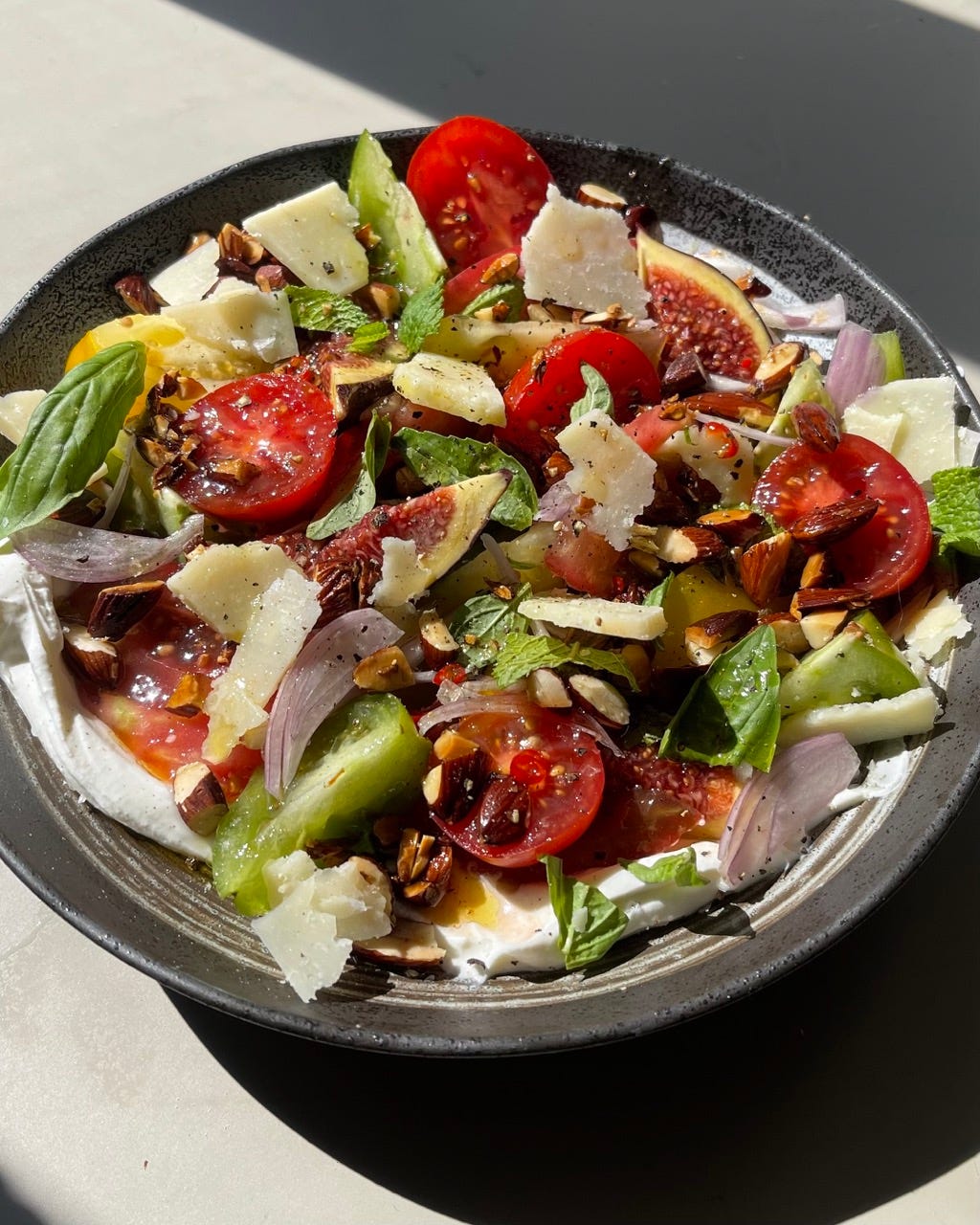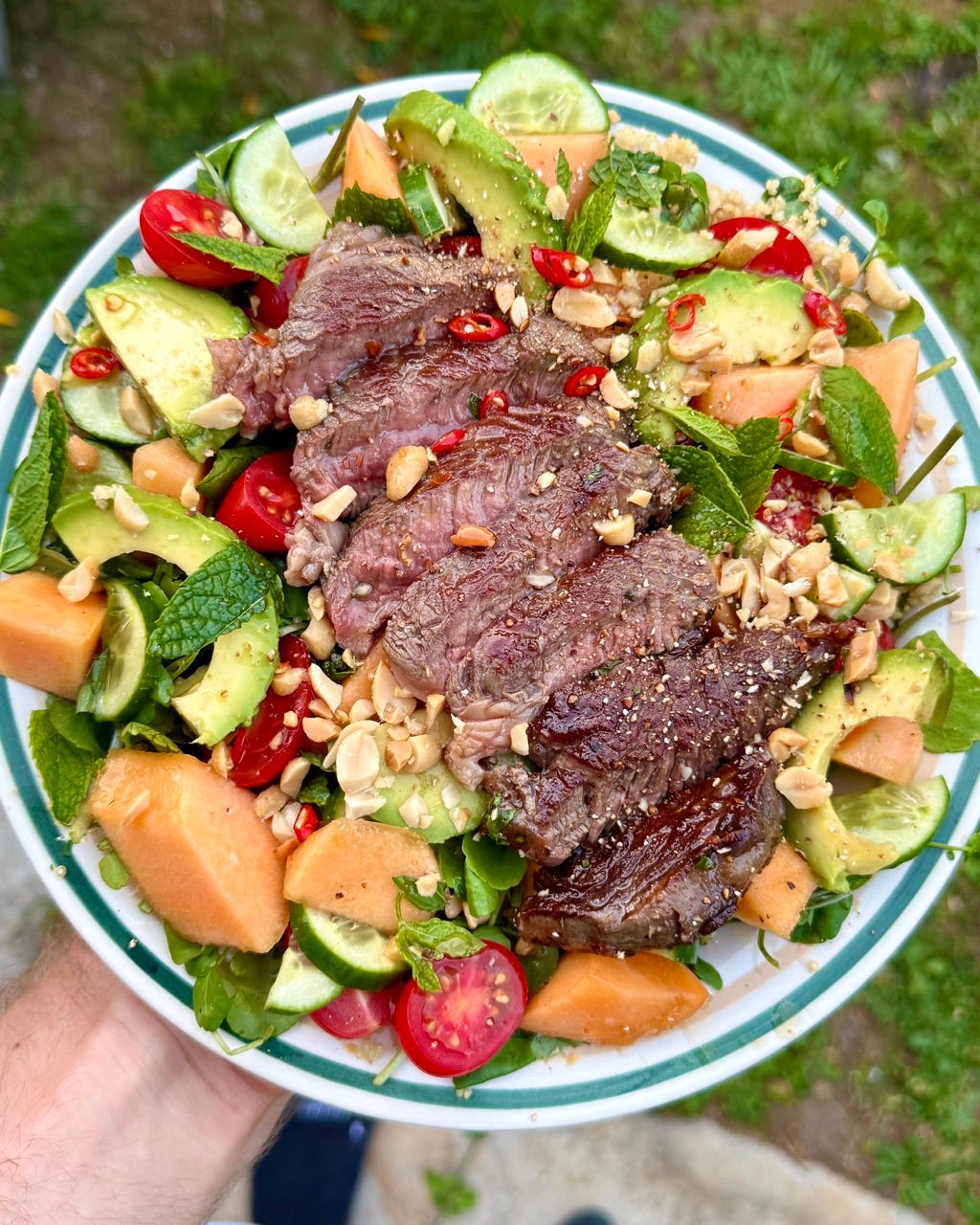I was going to start this by comparing a great salad to a great improv jazz session: all contrast, unexpected twists, and somehow it just works.
But then I remembered: most people don’t actually like improv jazz. It’s confusing. It can sound like a bunch of instruments talking over each other, each doing their own thing, with no one keeping the beat. Unless you’re a seasoned listener (I’m not), it’s more chaotic than cool.
And honestly? That’s exactly what a bad salad is like.
You’ve got sad iceberg competing with tasteless chicken. A random grape shows up like a sax solo no one asked for. And somehow, the dressing, if there is any, is like the missing bass that was supposed to hold the whole thing together.
But a good salad?
It’s more like an ABBA song in the car. Bright, balanced, irresistibly catchy. That’s what we’re building today.
The Weekly Zhuzh ✨
Your toolbox on how to make salads that sing
A good salad has layers of flavour and texture like a good song has layers of vocals, melody, and tempo (ok, this is where my music knowledge and analogy ends, my apologies.)
First, I want you to understand that a good salad is all about contrast. Contrast in flavour and contrast in texture. Generally, I approach my salads by using the following components:
Something fresh
Something creamy
Something crispy
You’ll find these elements in all of the different categories below. You’ll get to salad nirvana once you’ve understood how to mix and match to achieve balance between them.

The Base: aka your salad canvas
Purpose: Gives your salad substance and is the canvas you paint upon.
Hearty Carbs: Steamed quinoa, roasted sweet potato, lentils, rice noodles
Leafy Greens: Lettuce, rocket, shredded kale, baby spinach, watercress
Creamy foundations: hummus, labneh, Greek yogurt, whipped feta
The Vegetables
Purpose: Bulk up your salad and add flavor and nutrition
Fresh: Tomatoes, peas, green beans, cucumber
Cooked: Grilled zucchini, roasted red pepper, roasted carrots, roasted mushrooms, broccoli
The Protein
Purpose: Makes your salad filling and satiating
Veg proteins: crispy tofu, beans, fried tempeh, soy protein
Dairy/egg: pan-seared halloumi, cottage cheese, jammy boiled eggs
Meat: Grilled chicken, canned tuna, smoked salmon, seared steak
The Toppers: where the magic happens
Purpose: Arguably the most important differentiator between a sad salad and a good salad. Toppers are what make your salad interesting and fun to eat.
Salty toppers: Olives, capers, feta cheese, blue cheese
Fresh toppers: Pickled, sliced red onions, stone fruits, orange segments, fresh herbs
Crunchy toppers: Toasted almonds, pistachios, sunflower & pumpkin seeds, corn nuts, toasted croutons
Creamy toppers: Avocado, Hummus, Mozzarella,
The Dressing
Purpose: Adds and carries flavor, like flavour lubricant
Simple: Olive oil, lemon/vinegar, and salt, or yogurt with lemon, salt, and water.
Complex: Mustard vinaigrette, green goddess, miso lime
From here on, it is all up to your personal preferences. Try adding a few ingredients from the same category.
Many ingredients will fit into more than one category and some ingredients can also cover several purposes. But as long as you have something to cover the formula: fresh, creamy, crispy, you’re good.
Extra tip: Build your salad by color. Not only does this look delicious, but adjacent colors tend to taste nice together. Think grilled zucchini with peas and mint, or tomatoes with peach and chili oil.

Alright, ready for a recipe to apply what you’ve learnt?
The Nudge 🍽️
Thai-inspired beef & cantaloupe salad for Ann
I met my friend Ann over the weekend (a very funny woman), and she mentioned she’s been trying to combat her iron deficiency by eating more red meat. Whether you’re like Ann or not, you’ll most likely appreciate this salad.
It’s a great example of how to apply the salad toolbox: balancing spicy, sweet, and sour with crisp veg, juicy fruit, and rich steak.
Makes 2 portions
Ingredients
250–300g steak (sirloin, flank, or hanger works well, look for nice marbling)
1 cup cooked quinoa
¼ cantaloupe melon, cut into chunks
A handful of cherry tomatoes, halfed
1 small Persian cucumber, chopped
½ avocado, chopped
A handful of peanuts, crushed
Some fresh mint (or coriander)
A bag of watercress (or any leafy green)
For the dressing:
Juice of 1 large lime
1 garlic clove, minced
1 tbsp fish sauce
1 tsp sugar or honey
1 bird’s eye chili, finely chopped (or ½ tsp chili flakes)
Do this
Prep the steak:
Unpack, pat dry, and season well with salt on both sides. Let it sit while you prep the rest.Make the dressing:
Mix all dressing ingredients in a small bowl. Set aside.Prep the veg:
Chop everything so you’re ready to assemble quickly once the steak is done.Cook the steak:
Heat a heavy skillet over medium-high heat. Pat the steak dry again. Add 2 tbsp neutral oil (like canola), and once the pan is smoking hot, add the steak.Sear for 3–4 minutes on the first side until deeply browned.
Flip and sear the other side:
For thinner steaks (~2 cm): 1 more minute
For thicker steaks (3–4 cm): 3–4 more minutes, depending on doneness
Rest the steak:
Transfer to a plate and let it rest for a few minutes, then slice thinly across the grain.Assemble the salad:
On a large plate or shallow bowl, layer quinoa, watercress, melon, tomatoes, cucumber, and avocado. Top with sliced steak, then finish with peanuts, mint, and the dressing.
This week’s Little Feast was a bit longer than usual, so I’m skipping the Tool section to let your brain digest in peace.
If you found it useful, I’d love to hear from you — just leave a comment and let me know what you’re taking with you.
Thanks for reading,
Seb






Thank you so much for this beautiful recipe!!!!!!
Seb this recipe is so good! Had it for dinner this evening, thank you!